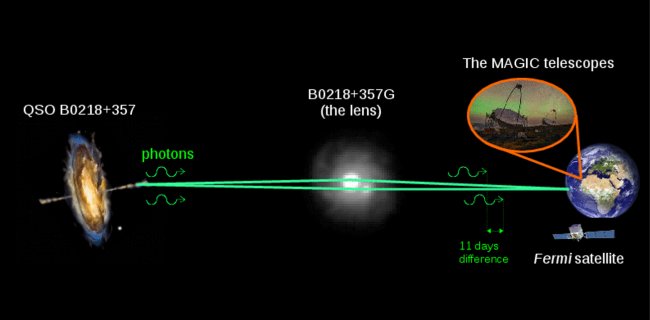MAGIC observes a gravitational lens at very high energies

MAGIC
In a study published last Friday in the journal Astronomy & Astrophysics, scientists of the international collaboration of the MAGIC telescopes (Major Atmospheric Gamma Imaging Cherenkov Telescope), located at the Roque de los Muchachos Observatory, in Garafía (La Palma), and among which are researchers of the Institute of Space Studies of Catalonia (IEEC), have announced the discovery of gamma-ray emission more distant than any previous detection. The discovery was made possible by the gravitational lensing caused by a massive galaxy between the quasar and Earth, that “repeated” the light produced by the source.
According to Einstein’s General Relativity, light is deflected passing close to a large mass. To a distant observer the mass focuses light like a giant lens. The result is a much brighter, although distorted, image of the source and a chance to see distant objects that might otherwise be far too faint to detect. And just like a lens, light can pass through the lens with slightly different path lengths. On cosmic scales, this means photons — parcels of light — traveling along different lines of sight arrive at slightly different times. If, in addition, the source is variable, this is “imprinted” on the light with a time delay relative to a fixed first arrival. And this should not depend on the energy of the photons, according to the theory. That makes such observations especially important.
QSO B0218+357 harbors a supermassive black hole in a galaxy located halfway across the Universe from Earth. Over 7 billion years ago a gigantic explosion occurred in this object, which led to the emission of an intense flare of gamma rays, which is the highest-energy form of light. In its long journey toward Earth, these photons passed in the vicinity of a foreground — still distant — galaxy, B0218+357G, over one billion years later. In passing and being deflected, those photons traveling along the shorter path finally arrived at Earth on July 14th, 2014 and were observed by the Large Area Telescope on board the orbiting Fermi satellite, which scans the entire sky every 3 hours. The detection of this gamma-ray outburst alerted the astronomical community, and many telescopes worldwide were immediately pointed at QSO B0218+357 to learn more from this distant cosmic explosion. Researchers operating the MAGIC telescopes, located on La Palma in the Canary Islands, became excited about the possible observation of this object in very-high-energy gamma rays. These could provide the most extreme perspective of this outburst, but, unfortunately, at that time there was full moon in La Palma, which prevented the operation of the MAGIC telescopes. The MAGIC telescopes measure very-high-energy gamma rays, which are a thousand times more energetic than those measured by Fermi, and a hundred billion times more energetic than any light we see from our Sun.
From the earlier measurements of this object in 2012 by Fermi and by radio telescopes the scientists knew that photons arriving along the longer path should arrive about 11 days later. “In other words, Nature could award us with a replay, a second chance to look at the same interesting phenomenon.” says the MAGIC Collaboration member Julian Sitarek (University of Łódz, Poland and IFAE former member of the Institut de Fisica d’Altes Energies in Barcelona, Spain, when he started this project) who led this study, and continues: “When the time came, the MAGIC telescopes were pointed at QSO B0218+357, and, in accordance with the prediction, a flare of very-high-energy gamma rays was observed, making QSO B0218+357 the most distant object detected in the very-high-energy gamma-ray domain to date.” These very-high-energy gamma-rays from any distant source have a high chance to interact with the numerous low-energy photons emitted by galaxies and stars, being lost in the process. With this observation, MAGIC has doubled the previously known visibility range of the Universe in very-high-energy gamma rays. Observation of the delayed signal from QSO B0218+357 by MAGIC showed for the first time that these very energetic photons are also deflected in agreement with General Relativity, a result that is both striking and potentially profound. The signal arriving at the predicted time may rule out some theories of the structure of the vacuum. That awaits further analysis. For the moment, this observation demonstrates a new capability of the very-high-energy gamma-ray observatories and highlights what awaits the next generation of such telescopes, the Cherenkov Telescope Array (CTA) project.
MAGIC telescopes
MAGIC is a ground-based gamma-ray instrument located on the Canary island of La Palma, Spain. The system of two 17m diameter Cherenkov telescopes is currently one of the three major imaging atmospheric Cherenkov instruments in the world. It is designed to detect gamma rays tens of billions to tens of trillions times more energetic than visible light. MAGIC has been built with the joint efforts of a largely European collaboration that includes about 160 researchers from Germany, Spain, Italy, Switzerland, Poland, Finland, Bulgaria, Croatia, India and Japan.
More information:
Article: “Detection of very high energy gamma-ray emission from the gravitationally lensed blazar QSO B0218+357 with the MAGIC telescopes”, by M. L. Ahnen et al. A&A 595, A98, 2016.
http://www.aanda.org/articles/aa/abs/2016/11/aa29461-16/aa29461-16.html
MAGIC website: https://wwwmagic.mpp.mpg.de/
